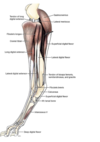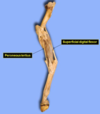Muscles of the Crus Flashcards
Craniolateral Muscles of the Leg
- Cranial tibial m.
- Long digital extensor m.
- Peroneus (fibularis) longus m.
- Lateral digital extensor m.
- Peroneus brevis m.
Lots of species differences on the size of muscles
Species difference on whether they are present or absent
Cranial tibial m.
(DOG)

Most cranial, most medial muscle in the dog
Tendon goes down to the tarsal region
Attachments:
(O): Extensor groove of tibia
(O): Lateral edge of cranial tibial border
(I): The plantar surface of the base of Metatarsals 1 and 2
Action:
- Flex the tarsocrucal joint
- Rotate the paw laterally
Innervation:
- Peroneal (Fibular) n.
Blood Supply:
- Cranial tibial a.

Long digital extensor m.
(Dog)
Attachments:
(O): Extensor fossa of the femur
(I): Extensor process of distal phalanges 2
(I): Extensor process of distal phalanges 3
(I): Extensor process of distal phalanges 4
(I): Extensor process of distal phalanges 5
Action:
- Extend the digital joints
- Flex the tarsal joints
- Has to happen together
Innervation:
- Peroneal (Fibular) n.
Blood Supply:
- Cranial tibial a.
** Need to remove the cranial tibial m.**

Crural extensor retinaculum
Long digital extensor runs under in the distal crus

Peroneus longus m.
DOG
(Fibularis longus m.)

Attachments:
(O): Lateral condyle of the tibia
(O): Proximal end of the fibula
(O): Lateral epicondyle of the femur
(I): 4th Tarsal bone
(I): Plantar aspect of the base of the metarsals
Action:
- Flex the tarsal joints
- AKA the “hock”
- Rotate the paw medially
Innervation:
- Peroneal (Fibural) n.
Blood Supply:
- Cranial tibial a.

Peroneus brevis m.
DOGS ONLY!!!

- Don’t need to disect
Arises in distal 2/3 of fibula
Actions:
- Flex the hock
Innervation:
- Peroneal (Fibular) n.

Popliteus m.

Fasciae of the leg
- Similiar to the superficial fascia
- Corresponds to the region
- Superficial crural
- Tarsal
- Metatarsal
- Digital fasciae

Tarsal extensor retinaculum
Long digital extensor runs under in the tarsus

Lateral digital extensor m.
(DOG)
(Very small in the dog)

Attachments:
(O): Proximal lateral tibia and fibula
(I): Digit 5
Action:
- Flex the tarsal joints and extend digit 5
Innervation:
- Peroneal (Fibular) n.
Blood Supply:
- Cranial tibia a.

Long digital extensor m.
(Horse)

Most cranial muscle in the horse
- Large muscle located cranially and superficially
- Peroneus tertius m. (underneath)
Attachments:
(O): Extensor fossa (distal femur)
(I): Dorsal surface of phalanges, primairly on P3 (extensor process)
Action:
- Extend the digital joints
- Flex the tarsal joints
- Has to happen together
Innervation:
- Fibular n. (Peroneal n.)
Blood Supply:
- Cranial tibial a.

Species difference for Horses
Absent in horses:
- Peroneus brevis m.
- Peroneus longus m.
Deep to Long digital extensor m. is Peroneus tertius m.
Peroneus tertius m.
(Horses)

- Deep to the long digital extensor m.
- Looks like a tendon
- Entirely tendinous in adult horse
- Partially wrapped in the long digital extensor m.
Attachments:
(O): Extensor fossa of the femur
(I): Dorsal tendon:
- Proximal extremity of metatarsal bone & 3rd tarsal bone
(I): Lateral tendon:
- Calcaneus & 4th tarsal bone
Action:
- Link stifle and hock
- Flex the hock
Innervation:
- Peroneal n.

Clinical Correlation:
Horse with a ruptured Peroneus tertius m.

The horse is able to extend the hock when the stifle is flexed
Result = Overextension of the hock
Shouldn’t happen because the hock (ankle) should be flexed
Actions are linked!
Lame on trot

Cranial tibial m.
(Horses)
Deep to Peroneus tertius m.
Largely covered by the long digital extensor m.
Attachments:
(O): Tibial tuberosity and lateral condyle of tibia
Inserts with 2 tendons:
(I): Dorsal Tendon
- Dorsal aspect of the proximal end of the 3rd metatarsal bone
(I): Medial Tendon/Cunean Tendon
- Fused 1st and 2nd tarsal bones
Innervation:
- Peroneal (Fibular) n.
Blood Supply:
- Cranial tibial a.

Bone Spavin

Bony growth within the lower hock joint of horse or cattle
Most common cause of clinical lameness of the tarsus (“hock”) in horses
Caused by osteoarthritis
Enlargement of medial aspect of the hock, under the cunean tendon
Repair:
Cunean tenectomy
- Cut tendon
- Really severe osteoarthritis cases –> joint fusion
Lateral digital extensor m.
(Horses)

Caudal to the long digital extensor m.
Actions:
- Flex the hock
- Extend the tarsus
Innervation:
- Peroneal n.
Blood Supply:
- Cranial tibia a.































